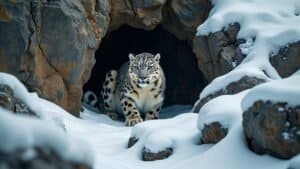Introduction
Recognizing signs of snow leopard presence in their natural habitat is crucial for conservation efforts and wildlife enthusiasts. Snow leopards, elusive and often unseen, leave behind specific signs that indicate their presence
This guide will explore key indicators such as tracks, scat, scent marks, and scratch marks, helping you identify these majestic creatures in their mountainous environments
Understanding these signs not only enhances your chances of spotting a snow leopard but also contributes to their preservation by raising awareness of their habitats
Identifying Snow Leopard Tracks
Snow leopards are elusive and highly adapted to their rugged environments, making direct sightings rare. However, one of the most telltale signs of their presence is their tracks
Understanding the characteristics of snow leopard tracks and how they differ from those of other animals is essential for identifying their presence in the wild
Snow Leopard Paw Print Characteristics
Snow leopard tracks are distinctive due to their large size and the shape of their paw prints. A typical snow leopard paw print measures around 3.5 to 4 inches (9 to 10 cm) in length and width, which is relatively large compared to other animals in their habitat
The paw print features four toe pads and a heel pad, which may appear rounded. A key characteristic of snow leopard tracks is the absence of claw marks. This is because snow leopards, like other big cats, retract their claws while walking to prevent them from getting blunted
The paw prints may also appear somewhat blurred or indistinct in deep snow due to the snow leopard’s wide paws, which act as natural snowshoes, distributing their weight and allowing them to walk on snow without sinking too deeply
Differentiating Snow Leopard Tracks from Other Animals
While snow leopard tracks are unique, it’s important to distinguish them from those of other animals that share their habitat, such as wolves and lynxes
Wolf tracks, for instance, are also large but tend to show claw marks and have a more elongated shape. Lynx tracks, on the other hand, are smaller, and though they also lack claw marks, they have a more pronounced heel pad indentation and are usually more circular than snow leopard tracks
Another crucial factor in differentiating snow leopard tracks is the track pattern. Snow leopards often walk in a straight line, placing their hind feet directly in the prints of their front feet, a behavior known as direct registering
This pattern contrasts with that of wolves, which tend to trot in a zigzag or weaving pattern. The direct registering of snow leopards helps them conserve energy and maintain balance on steep and uneven terrain
Best Locations to Find Snow Leopard Tracks
Snow leopard tracks are most commonly found in high-altitude regions, particularly in areas with sparse vegetation, rocky outcrops, and near ridgelines where these big cats are known to travel
They are also often found along snow-covered trails, riverbeds, and near kill sites where snow leopards may have hunted their prey. Tracks are easiest to spot shortly after a fresh snowfall, which preserves the prints before wind or additional snowfall can obscure them
Experts recommend looking for tracks early in the morning or late in the afternoon when the sun is low, casting shadows that make the tracks easier to see. If you’re tracking snow leopards, it’s also important to consider the altitude and terrain
Snow leopards are typically found at elevations ranging from 9,800 to 16,500 feet (3,000 to 5,000 meters), although they can venture lower during winter when prey migrates to lower altitudes. Therefore, tracking efforts are most successful in these high-altitude environments where the presence of snow leopard tracks is more likely
Tracking snow leopards requires patience and a keen eye for detail, but the discovery of their tracks can be an incredibly rewarding experience, offering a rare glimpse into the movements of these elusive predators
By recognizing the distinct features of snow leopard tracks, differentiating them from other animals, and knowing where to look, you can significantly increase your chances of identifying their presence in the wild
Recognizing Snow Leopard Scat
One of the most reliable indicators of snow leopard presence in a region is their scat. Scat, or feces, provides valuable information about the diet, health, and behavior of snow leopards. By learning how to identify snow leopard scat, you can gain insights into their presence and activities in the wild
Common Traits of Snow Leopard Scat
Snow leopard scat typically appears cylindrical in shape and is composed of segments, often with blunt ends. The size of the scat can vary, but it usually measures between 0.8 to 1.2 inches (2 to 3 cm) in diameter and 3 to 6 inches (7.5 to 15 cm) in length
The color of fresh scat ranges from dark brown to black, depending on the snow leopard’s recent diet. As the scat ages, it tends to turn a lighter color, often becoming grayish due to exposure to sunlight and the breakdown of organic material
One of the most distinctive features of snow leopard scat is the presence of undigested fur, bones, and sometimes even hooves of their prey. Since snow leopards primarily hunt large ungulates like blue sheep and ibex, the scat often contains coarse hair and fragments of bone, which are not fully digested
This content can help differentiate snow leopard scat from that of other carnivores, such as wolves or foxes, whose scat may also contain fur but is generally smaller in size and lacks the same large bone fragments
Scat Composition and What It Reveals
Analyzing the composition of snow leopard scat can provide insights into their diet and hunting behavior
Typically, the presence of large bones or hooves indicates that the snow leopard has recently consumed a large ungulate. However, during times when large prey is scarce, the scat may contain remains of smaller animals like hares, marmots, or birds
Researchers often collect scat samples for DNA analysis, which can confirm the presence of snow leopards in a given area. This non-invasive method allows scientists to study snow leopard populations and monitor their health without disturbing the animals
DNA analysis of scat can also reveal genetic information, such as relatedness between individuals, and help in identifying different snow leopard populations
Scat is also used to determine the snow leopard’s range and territorial behavior. Snow leopards are known to defecate in prominent locations, such as along trails, at the base of cliffs, or near scent-marking sites
These strategic placements serve as a form of communication with other snow leopards, marking territory boundaries and signaling presence to potential rivals or mates
Seasonal Changes in Snow Leopard Scat
The composition and appearance of snow leopard scat can vary with the seasons, reflecting changes in their diet. During the harsh winter months, when prey is harder to find, snow leopards may consume more carrion or smaller animals, leading to scat that contains fewer large bone fragments
In contrast, during the spring and summer, when ungulates are more abundant, the scat is likely to contain more significant amounts of fur and large bones
Seasonal changes also influence where you might find snow leopard scat. In winter, as snow leopards follow migrating prey to lower altitudes, their scat is more likely to be found in these lower regions
Conversely, in summer, as prey moves to higher elevations, snow leopard scat can be found in higher mountainous areas
Recognizing and analyzing snow leopard scat is a crucial skill for wildlife trackers and researchers. By understanding the common traits, composition, and seasonal variations of snow leopard scat, you can gather valuable information about their presence and behavior
This knowledge not only aids in tracking these elusive cats but also contributes to their conservation by providing data that helps protect their natural habitats
Understanding Snow Leopard Scent Marks
Snow leopards, like many other big cats, rely heavily on scent marking to communicate with other members of their species. Scent marks are one of the more subtle yet definitive signs of their presence in a territory
Understanding how and where snow leopards mark their territory can provide crucial insights into their behavior and movements
How Snow Leopards Mark Their Territory
Snow leopards mark their territory using a combination of urine spraying, scraping, and rubbing. These scent marks serve multiple purposes: they establish territory boundaries, signal reproductive status, and communicate the presence of an individual to other snow leopards
The scent marks are often placed in prominent locations that are easily noticed by other animals, such as along trails, near ridgelines, or at the base of cliffs
Urine spraying is one of the most common methods used by snow leopards to mark their territory. They back up to a vertical surface, such as a rock or tree, and spray urine at a height that corresponds to the size of the animal
The strong-smelling urine contains chemical cues that convey information about the individual’s identity, age, sex, and reproductive status. The scent can persist for weeks, especially in colder climates, making it an effective way to maintain territory boundaries over time
In addition to urine spraying, snow leopards also engage in scraping behavior. They use their hind legs to scrape the ground, creating shallow depressions in the soil, which they then scent mark with urine or feces
These scrapes are often found on flat surfaces along trails or near resting spots. The combination of visual and olfactory signals makes scrapes particularly effective at communicating with other snow leopards
Types of Scent Marks and Their Meanings
There are several types of scent marks that snow leopards leave behind, each with its specific meaning and purpose. Urine sprays are primarily used to delineate territory and signal reproductive readiness
Males, in particular, are known to increase their marking activity during the breeding season, spraying more frequently and in more prominent locations to attract females
Scrapes serve as both visual and olfactory markers and are typically associated with territorial boundaries. The presence of fresh scrapes along a trail or ridgeline is a strong indicator of recent snow leopard activity
In addition to marking territory, scrapes can also serve as a signal of dominance, as larger, more powerful individuals tend to create larger and more frequent scrapes
Another less common but still significant type of scent mark is the cheek rubbing. Snow leopards have scent glands located on their cheeks, which they use to rub against objects such as rocks or tree trunks
This behavior deposits scent from the glands onto the object, leaving a chemical signature that can be detected by other snow leopards. Cheek rubbing is often associated with comfort or marking familiar locations rather than with aggressive territorial marking
Locations Most Likely to Have Scent Marks
Snow leopard scent marks are typically found in specific locations within their territory. These include trails and ridgelines, which serve as major travel routes for these big cats
Because snow leopards often use the same trails repeatedly, these areas are prime spots for finding scent marks. Other common locations include rocky outcrops, the bases of cliffs, and near water sources
Scent marks are also frequently found at territorial boundaries, where snow leopards are most likely to encounter neighboring individuals. These boundary areas are marked more intensively to prevent intrusions by other snow leopards
When searching for scent marks, it’s important to focus on areas that provide good vantage points or easy access routes, as snow leopards prefer to mark locations that are easily visible and accessible to other members of their species
By understanding the different types of scent marks and knowing where to find them, you can gain valuable insights into the presence and behavior of snow leopards in a given area. Scent marks not only reveal the locations of these elusive animals but also provide information about their social structure, territorial boundaries, and reproductive status
For researchers and wildlife enthusiasts alike, identifying and interpreting these scent marks is an essential skill in the study and conservation of snow leopards
Observing Scratch Marks and Other Signs
In addition to tracks, scat, and scent marks, snow leopards leave behind a variety of other physical signs that can indicate their presence in an area
Among the most notable of these are scratch marks on trees, rocks, and the ground. Understanding how to identify these and other subtle signs can provide further evidence of snow leopard activity
Identifying Claw Marks on Trees and Rocks
Scratch marks made by snow leopards are typically found on trees, rocks, and sometimes on the ground. These marks are created by the snow leopard’s claws, which are used to sharpen and clean their claws or to mark territory
Claw marks can appear as deep gouges or shallow scratches, depending on the surface and the force applied by the snow leopard
On trees, scratch marks are usually vertical, running up and down the trunk. These marks can range in height from 2 to 6 feet (0.6 to 1.8 meters) above the ground, depending on the size of the snow leopard
The spacing between the claw marks can also help distinguish them from marks made by other animals, such as bears. Snow leopards have five toes on each paw, so the scratches will often show a pattern of four parallel lines if made with one paw or more if both paws are used
On rocks, scratch marks may be more irregular, as the hard surface makes it difficult for the claws to leave deep impressions. However, scratch marks on rocks are often found near scent marking sites, suggesting they serve a similar communicative function
In some cases, these scratch marks can be accompanied by fur or even claw sheaths, which can provide additional evidence of snow leopard activity
Recognizing Snow Leopard Resting Spots
Snow leopards, like all big cats, have favored resting spots within their territory
These spots are often found in secluded areas that provide shelter from the elements and a good vantage point to observe their surroundings. Common resting spots include caves, overhanging rocks, and dense shrubbery
Evidence of snow leopard resting spots includes flattened vegetation, fur left behind on rocks or in caves, and sometimes even tracks leading to and from the site
These resting spots are often reused, so the signs can accumulate over time, making them easier to identify. In winter, resting spots may also be indicated by patches of flattened snow where the snow leopard has lain down
Resting spots are typically located in areas that offer both protection and a strategic view of the surrounding terrain. Snow leopards are known for their ability to blend into their environment, so their resting spots are often chosen for their camouflage potential, making it difficult for potential prey or other predators to spot them
Other Subtle Signs of Snow Leopard Presence
Beyond the more obvious signs like tracks, scat, and scent marks, there are several other subtle indicators of snow leopard presence that can be observed with careful attention
One such sign is the presence of prey remains, such as bones or fur, which can indicate a recent kill. Snow leopards are known to drag their prey to secluded locations before feeding, so finding scattered bones or partially eaten carcasses can suggest that a snow leopard has been in the area
Another subtle sign is the presence of fur caught on branches or rocks. Snow leopards have thick, dense fur that can easily snag on rough surfaces as they move through their environment. This fur can often be found near scent marking sites or along narrow trails used by the snow leopards
Finally, snow leopards sometimes vocalize, especially during the mating season. Their calls are often described as low, throaty growls or a sound similar to a saw cutting through wood. While hearing these calls is rare due to the snow leopard’s secretive nature, it is a definitive sign of their presence when it does occur
Observing these scratch marks and other subtle signs requires patience and a keen eye. However, these indicators can provide crucial clues to the presence of snow leopards in an area, helping researchers and wildlife enthusiasts to track these elusive animals more effectively
By paying close attention to these less obvious signs, you can deepen your understanding of snow leopard behavior and contribute to their conservation efforts
Conclusion
Recognizing the signs of snow leopard presence in an area involves a keen understanding of various indicators such as tracks, scat, scent marks, scratch marks, and other subtle clues
Snow leopard tracks, with their unique paw prints and direct registering pattern, provide clear evidence of their movement through high-altitude terrain. Scat analysis offers insights into their diet and territorial behavior, while scent marks reveal how these elusive cats communicate and establish their territory
Scratch marks on trees and rocks, as well as other subtle signs like prey remains and fur caught on branches, further confirm their presence. By mastering the ability to identify these signs, wildlife enthusiasts and researchers can play a vital role in snow leopard conservation, helping to protect these majestic animals and their habitats













